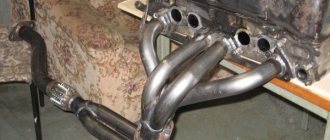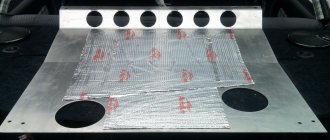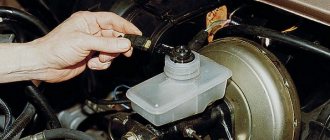Internal combustion engines are characterized by rather low efficiency. Power lovers are trying to correct the situation with various modifications. For example, many mechanics focus their efforts on improving exhaust and intake systems by installing a 4-1 or 4-2-1 spider to increase engine power.
If all obstacles are removed as much as possible inside the exhaust manifold, the power unit will operate more efficiently. Therefore, theoretically, to achieve this result, it is advisable to remove the catalyst. How justified this is and which system is better should be examined in more detail.
Replacing the Lada Kalina catalyst: reasons for replacement
The most common reason that entails the installation of a spider instead of a catalyst is clogging of the honeycomb of the base of the catalytic element, both by fuel combustion products and by exfoliating particles of the base itself.
Natural degradation is normal. The catalyst, under favorable operating conditions, is designed for a service life of about 100 thousand kilometers.
Let's take a closer look at the moments when replacing the catalyst on a Lada Kalina car becomes necessary.
There are a number of factors that can significantly accelerate the destruction of the device:
- Problems with the formation of the correct fuel-air mixture. Both rich and lean mixtures have a negative effect here. A rich mixture leads to incomplete combustion of hydrocarbons and their deposition on the walls of the base cells. A lean mixture causes an abundance of oxygen in the exhaust gases, which has an oxidizing effect on the body at high temperatures. Also, due to an insufficient amount of fuel in the cylinder, misfires occur and unburned fuel is released into the catalyst. It can ignite while already in the manifold with the next portion of hot exhaust gases.
- Incorrect ignition timing. The fuel-air mixture is ignited at the wrong time. This leads to improper combustion and the formation of additional thermal loads on the catalyst.
- Gasoline is of poor quality. Gasoline saturated with impurities, after combustion, leaves soot deposits on the walls of the cells. In this case, rapid clogging of the catalytic element occurs.
- Coolant or oil getting into the cylinders. A leak in the lubrication and cooling systems leads to unauthorized penetration of working fluids into the combustion chamber. When they are burned, compounds are formed that lead to clogging or destruction of the catalyst.
In addition to the breakdown of the catalytic element itself, the housing itself often fails due to design flaws. The weld at the junction of the pipes of the first and fourth cylinders with the catalyst body is often destroyed. The escaping exhaust gases create increased noise. Exhaust also penetrates the interior, causing discomfort.
A failed catalyst increases the load on the engine, as it creates resistance to the passage of exhaust gases. This may manifest itself in the following symptoms:
- increased fuel consumption;
- reduction in engine power;
- failures when trying to accelerate sharply;
- reduction in maximum speed;
- problems with starting.
Summary
According to some motorists, after tuning the car becomes faster, there is no hysterical roar when the revolutions approach 5,000. The exhaust sound has also changed, it has become more pleasant. In most cases, there is a decrease in fuel consumption. The financial component is also very noticeable - installing a 4-2-1 spider costs at least half as much.
Hi all. While I'm planning a trip to Togliatti to buy some goodies, I've thought of a temporary solution with release. Namely, I bought an insert to replace the 4-1 “spider” type catalyst. Since the engine is flashed for Euro-2, the cat has already become an unnecessary blockage of exhausts and in order not to “dirty” the new catalyst and preserve its originality, it was safely replaced with an insert. I rearranged one lambda and that's it. I did not change the gasket when replacing it. Additionally, I only bought 3 bolts with copper nuts.
In general, I might not have written this, if not for one BUT. Maybe someone will encounter this problem. After the replacement, the car began to stall. Almost imperceptibly... almost unrecognizable, but it began to dull. I was very surprised because I was hoping for exactly the opposite result. After thinking, I decided to reset the ECU unit with its initialization. I performed a reset using the OBD-2 adapter. After waiting a minute the throttle adapted and voila. The car drove))) although it drove more optimally only after 40-50 km (fuel map EPT).
What can I say. She became more playful. A little. After all, everything else is stock. But there is a catch. True, the pickup is felt only at high speeds. Consumption has become level. The exhaust sound at the bottom did not change, only after 3 thousand revolutions. I like.
Replaced it with warranty providers. I remain under warranty))) As they say, don’t have a hundred rubles...
- high noise level;
- exhaust gases entering the cabin;
- increased fuel consumption;
- reduction in engine power.
Replacing the catalyst on Kalina: preliminary diagnostics
When an error “Check Engine” appears on the dashboard, it is necessary to perform computer diagnostics of the electronic control unit.
Our service specialists will perform computer diagnostics and determine the causes of errors that appear. If the error is caused by the operation of the catalyst, it is necessary to either replace it or install a spider. Thus, diagnostics allows you to make an informed decision about what would be better: replacing the catalyst with a Kalina flame arrester or installing a spider.
Is it necessary to flash the car after removing the cathode collector?
As soon as the catalyst is cut out, the second oxygen sensor, which is used to diagnose it, will quickly “detect the loss.” The corresponding signal will go to the engine ECU. The controller will begin to inject gasoline in emergency mode, and the Check Engine icon will light up on the panel.
To prevent this from happening, the control unit needs to be reflashed! The task of the new controller firmware is to disable the recording of data from the oxygen sensor installed after the converter.
Replacing the catalyst with a spider
Replacing the catalyst with a spider on Kalina begins with selecting a substitution element.
There are several options for spiders for Lada Kalina cars:
- designs 4-1;
- 4-2-1 designs;
- 4-2-1 designs with modified sound.
The most common is 4-1. It consists of four pipes welded to the cylinder head mounting plate, which converge into one. Depending on the environmental class, they have one (for EURO-2) or two (for EURO-3) threaded holes for installing lambda probes.
More efficient in terms of exhaust gas removal is the 4-2-1 spider. It also consists of four pipes welded to a thick-walled metal plate, which is the receiving part of the exhaust manifold. The pipes of the first and fourth cylinders are connected into one, as well as the pipes of the second and third. After about half a meter, these two pipes are also connected to each other into one and transmit exhaust gases further into the exhaust system. This design is technologically more advanced, since its resonant oscillations are much smaller. It is more difficult to implement and more expensive. But in some cases it gives an increase in engine power of up to 5%. When installing, it requires shortening the segment of the exhaust pipe following the spider, since the spider itself is longer than a standard manifold with a catalyst.
The 4-2-1 Spider with a sound modifier is structurally the same as a regular 4-2-1. But one of the pipes is extended by creating an additional turn. This gives the exhaust sound an unusual timbre.
Technical features of the insert for Lada Kalina 8V
The industry offers two types of tuning inserts, the design of each of them depends on the location of the pipes. Moreover, each design is designed for a specific power unit:
- Insert 4-1 is installed on forced engines with a speed range from 5,000 to 10,000 rpm. structurally suitable only for 16-valve engines.
- The 4-2-1 insert operates over a wider range and is considered a "low-end" insert. It is possible to increase engine power by about 3-5%. This is the model most often installed on the VAZ 1118.
Since it will not be possible to install a preliminary flame arrester , you will have to carefully approach the issue of choosing an insert. The installation process of the part will not take much time if you follow all the recommendations.
Replacing the catalyst on Kalina (8 valves): installing a spider
All threaded connections are pre-filled with a liquid wrench. As a rule, nuts are highly corroded when exposed to high temperatures, and unscrewing them is a big problem.
After this, disassembly is carried out in the following sequence:
- the coolant is drained;
- the lambda probe chip (or two, depending on what class) is disconnected;
- unscrew the bolts securing the intake manifold from the cylinder head and the exhaust pipe;
- the holding bracket is removed;
- the exhaust manifold is dismantled;
- the front lambda probe wire is extended;
- spider is installed;
- the system is assembled in reverse order.
Pipe selection
When choosing heating pipes, not only the diameter is of great importance, but also the material from which they are made, and, more precisely, the smoothness of their walls, since this fundamentally affects the system.
Also, the choice of material is greatly influenced by the boiler, since in the case of solid fuel, preference should be given to steel, galvanized pipes or stainless steel products, due to the high temperature of the working fluid.
However, metal-plastic and reinforced pipes require the use of fittings, which significantly narrows the clearance; reinforced polypropylene pipes will be an ideal option at an operating temperature of 70C and a peak temperature of 95C.
Products made from special PPS plastic have an operating temperature of 95C, and a peak temperature of up to 110C, which allows use in an open system.
Replacing the catalyst on Kalina (16 valves): installing a spider
Due to a more complex and extensive power supply and gas distribution system, installing a spider on a 16 valve engine is a more energy-intensive task.
The sequence of work is as follows:
- The terminals are disconnected from the battery and the coolant is drained.
- The clamps securing the air duct pipe from the throttle assembly to the filter are loosened. The pipe is removed.
- The chip is disconnected from the throttle assembly connector and the oxygen sensor chip.
- The crankcase ventilation system hose is disconnected.
- The adsorber purge hose is disconnected.
- The receiver mounting bracket is unscrewed.
- The fastening nuts are unscrewed and the receiver is removed.
- The upper and lower nuts securing the heat-insulating shield and the eye are unscrewed and dismantled.
- The fastening of the spacer to the exhaust manifold is unscrewed.
- The heat shield is dismantled.
- The intake manifold is removed. To do this, unscrew nine fastening nuts at the cylinder head and three nuts at the exhaust pipe.
- The exhaust manifold is dismantled.
- The spider is installed.
- The wire of the first oxygen sensor is extended. Lambda probes are screwed into the spider. For the control sensor, a mechanical blende is provided in the spider. It is also possible to flash the ECU at the request of the client. If the car is EURO-2 class, then there is only one hole for the sensor.
- Installation is carried out in reverse order.
- high noise level;
- exhaust gases entering the cabin;
- increased fuel consumption;
- reduction in engine power.
Technology for changing the catalytic converter to the 4-2-1 insert
To work, you need to prepare a set of keys for 13, 17, 19 and 22, you also need a socket head for 13 and a screwdriver with a flat blade. Parts you should purchase are two bolts with springs, a graphite connecting ring, an extension for the sensor, and a manifold gasket. Since the spider with tubes is longer than the standard neutralizer, it would not hurt to purchase a corrugation with double or triple braiding 200 mm long.
You must first remove the negative terminal from the battery. The further process of dismantling the standard part continues according to the following diagram:
- Remove the intake module using a 13mm socket, disconnect the injector wiring harness and the fuel supply hose.
- Unscrew the nuts securing the flanges of the intake pipe and catalytic converter, and then remove the pipe flange from the converter studs.
- Disconnect the oxygen sensor connectors and disconnect the wiring harness from the heat insulation shield.
- Unscrew the two nuts securing the catalytic converter bracket and remove the clamp.
To finally replace the standard catalyst on Kalina 8 valves with a modified spider, all that remains is to slide the flange off the studs and pull the assembly down. The head gasket seating areas should be cleaned.
The flange is cut off from the old catenary collector with a grinder and welded to a section of the pipe with corrugation. A snag is screwed into the sensor hole or the ECU is subsequently reflashed. These measures will get rid of the Check-Engine, and will also be cheaper than buying a new converter.
Spider or Flame Hider
The exhaust system consists of several parts, each of which plays an important role. These include the exhaust pipe, catalyst, resonator and the muffler itself. The main functions it performs are noise reduction and reduction in the emission of harmful gases. Also, there is often a corrugation on the receiving pipe, designed to reduce vibration. A malfunction of any part of the exhaust system can affect the condition of the entire car and many other parts in particular, so it is necessary to regularly diagnose this element of the car.
Vertical scheme
Liquid glass for cars: why is it needed, how much is enough
One of the main differences between a vertical single-pipe heating system is the presence of a circulation pump in it. It is this that creates the necessary pressure in the pipes, which ensures the fastest possible circulation of the coolant.
Vertical heating scheme
However, even when a vertical heating system in Leningrad is installed, the coolant can move independently. With natural water flow, it is recommended to install main pipes of larger diameter. Accordingly, if there is a pump in the circuit, the pipes can have any, even small, diameter. In this case, the natural flow of the coolant requires a slope of the main line in the vertical circuit (as well as in the horizontal one).
If a system is chosen that does not involve the use of a circulation pump, the line should not have a length of more than 30 m. Another minor, but still rather unpleasant drawback is the less aesthetic appearance of the room.
Leningrad heating system for a private house
A prerequisite for installing a vertical circuit is the presence of bypasses on each radiator. This will allow you to repair a separate radiator without stopping heating.
How to repair a muffler
If your car's muffler requires repair or complete replacement, it is not recommended to do this work yourself, since there is a high risk that you will only worsen the condition of the exhaust system, and possibly the entire vehicle as a whole. In order to prevent such a situation, contact only specialized car services. In our car service center, qualified specialists with the necessary competence in the field of working with exhaust systems will competently diagnose the exhaust system of your car, and, if necessary, repair or install a new muffler in the shortest possible time.
If you encounter any malfunction in the exhaust system and you need to diagnose it, repair it or replace the muffler, then our salon specialists will be happy to help you with this, since we carry out all types of this work!
When developing most modern cars, technical solutions are widely used in their design, the main task of which is to ensure maximum comfort for the driver and passengers of the vehicle. In addition, a car that comes off the assembly line today simply must be environmentally friendly: it pollutes the air minimally and creates a low level of noise when driving. Environmental standards are especially strict in Europe and the United States, but Russia is gradually moving in the same direction.
Reducing the amount of harmful exhaust into the atmosphere and the noise level of the machine is achieved through the design of the exhaust system and the operation of the catalyst, whose task is to neutralize the main toxic gases generated during engine operation. This is a necessary part of any car; in the West, a car cannot be operated without a catalyst, but in Russia the situation is somewhat different. The fact is that the catalyst is quite expensive (precious metals are used in its design), therefore, after the end of the service life of this element, various cheaper alternatives are sought for it.
One of the most common ways to replace a catalyst is to install a flame arrester in the vehicle's exhaust system. Currently, you can easily find a flame arrester for any type of engine; many well-known foreign and domestic manufacturers of automobile parts are engaged in their production. The most common is the so-called universal flame arrester; they are manufactured by such well-known brands as “Platinik”, “Asmet”, “Ferroz” (Poland), “Asso” (Italy), “Simons” (Finland), “Walker”, “ Universal" (Estonia), "Marmittesara" (Italy).
What is the design of a flame arrester? What are its pros and cons compared to a catalyst? Is it possible to install it yourself or is it better to contact a service station, and what is the optimal size of the flame arrester? What types of flame arresters are there?
Exhaust system Lada 4×4
The catalytic converter is considered a reliable design element of a modern car, and manufacturers do not provide regulations for its replacement. That is, in their opinion, the service life of the collector or element under the bottom of the car should be equal to the service life of the entire car. However, practice has shown that catalytic converters do not always serve flawlessly.
What could happen to her trawler?
The first malfunction of the active element of the catalytic collector is its melting, which manifests itself in the form of honeycomb sintering and leads to difficult passage of exhaust gases. This usually happens after the gas temperature threshold of 900 degrees is exceeded.
How long does a flame extinguisher last? Pros and cons of the device
Flame arrestors installed separately usually operate successfully for five to ten years. Collective flame arresters last less (up to five years), since they have to work in the “hottest” conditions. The lifespan of this car part can be even longer if it is made by a reputable company using high-quality materials. It is also necessary to take into account operating conditions, vehicle characteristics and mechanical effects on the product.
It should be noted that more often than the flame arrester itself, welds and exhaust pipes are destroyed.
Now a few words about the pros and cons of installing a flame arrester. The most significant advantage is the price of this device. By installing a budget flame arrester instead of an expensive catalyst, you can save a lot of money. The flame arrester is less demanding on fuel quality compared to the catalyst - this is its second absolute advantage. Since the quality of gasoline at our gas stations often leaves much to be desired, this advantage is quite significant. In addition, the flame arrester slightly increases engine power, since it has a direct-flow structure (and not a honeycomb, like a catalyst).
Of course, the flame arrester also has disadvantages (where would we be without them). The main one is environmental pollution. Without a catalyst, all outgoing exhaust gases go outside without any purification. So, if you care about clean air on the planet, then it is better to install a new catalyst.
To install a flame arrester, electric or gas welding is required, so doing it yourself is quite problematic. The installation of a manifold and a free-standing flame arrester is different because in the first case the exhaust manifold must be removed. However, it is hardly worth saving on this procedure: installing a collector flame arrester costs 6-8 thousand rubles, and a free-standing one costs 3-5 thousand rubles.
Let's sum it up
If it happens that the radio in your car stops reading flash drives, it’s not a big deal. There are many options for fixing this problem. Just read the three main directions in troubleshooting and start with the simplest thing - formatting a flash drive. If this does not help, you should check all visible connections of the radio, and also take into account the type of its behavior when connecting a flash drive. Then you can update the firmware of the device itself, which is also done quite simply if you have the factory instructions.
Otherwise, you will have to contact a service center to repair the hardware of the radio. This option promises you certain expenses for the services of specialists. It’s quite easy to get the necessary capabilities and return the radio to working order. If, after performing all the stated procedures, the problem remains, the radio will have to be replaced. However, for cars with a stationary music system this will be an incredibly difficult and expensive process, so you need to try and restore the music equipment. Have you ever had problems with radios and flash drives?
Varieties of radiator connection diagrams
It is typical that for good heating it is not enough that the boilers heat the water well
It is very important for the coolant to flow into the radiators to connect them correctly
In practice, an unregulated series connection is used for a single-pipe connection. True, this problem can be avoided if you use a two-pipe system. This system also does not use a regulator, however, if the radiator becomes airy, the system will function since water will flow through the jumper (bypass). True, this option is not suitable for a system such as a warm floor.
Installing two ball valves behind the jumper allows, by blocking the flow, to remove or turn off the radiators, without the need to stop the system. So, the correct calculation of heating radiators will allow you to equip the room with a heat accumulator.
Internal structure
Spiders have a complex internal structure. They have circulatory, excretory, respiratory, digestive, and nervous systems.
Digestive system
The intestinal canal runs directly from the mouth to the anus. Consists of 3 parts. Divided into the esophagus, stomach with five pairs of blind tubes, and intestines. Processing and absorption of nutrients occur in the stomach. The intestines include two branched urinary canals. Liver juice has an effect similar to that of the pancreas of higher vertebrates.
Foregut
Consists of the pharynx, sucking stomach, and esophagus. Covered with chitin. Equipped with powerful muscles. The esophagus is thin and tubular. Forms a right angle with the pharynx. The sucking stomach has the shape of a pyramid with 4 sides. It absorbs part of the food. It also helps with swallowing as it has strong muscles.
Stomach
The stomach of spiders is the anterior section of the midgut. It does not have an internal cuticle. Represents large branched protrusions. It happens: simple, intermediate, classic, complex. Connects to the intestine, which extends through the stalk into the abdomen.
Liver
Large bulge on the intestine at the beginning of the abdomen. Gray or brown. Consists of many blades (lobes). Surrounds all organs except the pulmonary sacs. Releases digestive enzymes and destroys semi-digested food particles.
Cloaca
A voluminous pouch at the end of the intestine. This is where excrement accumulates. The Malpighian vessels flow into it. It continues with the chitinous hindgut. Followed by the anus. Spiders defecate droplets of liquid. After drying, the stains from them become white with a dark center.
Respiratory system
The respiratory organs are unique. The hemolymph of many spiders contains the respiratory pigment hemocyanin. It speeds up metabolic processes. The number of spiracles corresponds to the number of respiratory organs.
Lungs
Consist of many plates. Their appearance resembles a stack of paper. Primitive groups of spiders have 4 lungs. In most spiders, the posterior pair of lungs is transformed into trachea. There are representatives who do not have this body. That is, according to the way they breathe, spiders are divided into:
- Quadruple lungs;
- bipulmonary;
- lungless.
Trachea
Oxygen enters them through air holes. According to development and location, there are local and general significance. The second ones extend into the cephalothorax and limbs. The first ones do not extend beyond the abdomen.
The trachea is more efficient for breathing than the lungs. This has been confirmed by experiment. The stigmata of spider lungs were covered with Vaseline. After 4-7 hours, blood circulation stopped. Then the spider died. Representatives of species with developed tracheae lived significantly longer during the experiment.
Interesting fact. The water spider has predominantly cutaneous respiration. With completely covered spiracles, it lives 4-15 days. Underwater it breathes oxygen, which collects between the hairs on the body.
Circulatory system
The circulatory system is not closed. Heart pulsating. Located in the abdominal cavity. It has lateral stomata that help pump hemolymph (the equivalent of white blood). When the heart contracts, blood enters the artery and the lateral stomata close like valves. Flows through the arteries to the extremities. It rotates around the lung sacs, then returns through the lateral stomata into the posterior vessel.
central nervous system
Consists of the brain and subpharyngeal nerve mass. Concentrated in the cephalothorax. It consists of paired ganglia that act as local control centers for all segments. The brain is created by the fusion of ganglia. Spiders have a centralized nervous system, characteristic of arachnids. There are two visual centers in the brain. One is responsible for the main eyes, the other for the others.
Despite having a relatively small central nervous system, some representatives exhibit complex behavior. For example, the ability to use trial and error.











